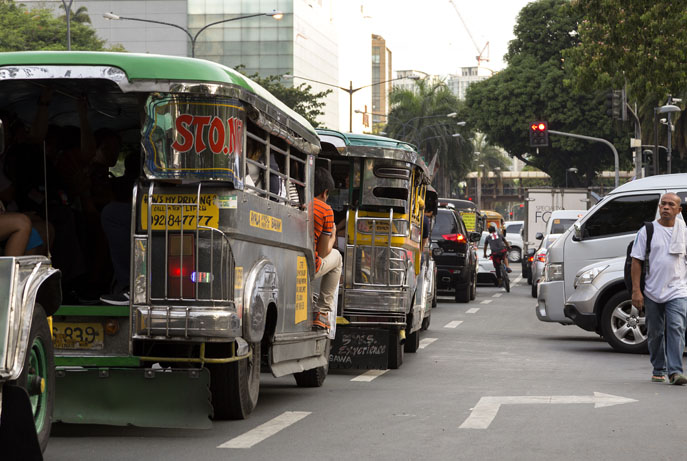COMMENT: Devin de Vries of WhereIsMyTransport says giving public transport users accurate information to plan their journeys is a model that can work as well in cities like Manila and Mexico City, where networks are informal, as it does in London
The path to sustainability for the transportation sector – the world’s fourth-biggest greenhouse gas emitter – is clear: get more people onto public transport, and fewer people using private vehicles.
Investment in electric and low-emission buses is accelerating, yet even buses that run on diesel have a lower environmental impact than cars. In the UK, buses and coaches account for just 6% of nitrogen oxide emissions from road transport, compared with 71% for diesel cars and vans. In the U.S., buses typically run at just one-quarter of capacity, yet the average bus trip is still more environmentally friendly than a car trip.
Our world continues to urbanise, bringing people closer to the option of public transport – 55% of the world’s population lives in a city, rising to nearly 70% in the next 30 years. In the world’s largest low- and middle-income cities, public transport is already the primary mobility choice.
For the 3.2 billion people who call emerging-market cities home, over 2 billion rely entirely on public transport
In many places, public transport is simply the best available option for getting where you need to go. In developed-market cities with good public transport networks (and potentially incentives to discourage car use, such as congestion pricing), public transport offers the quickest trip. In London, Beijing, or Boston, rich or poor, just about every citizen takes the metro or bus.
Public transport is also the best available option in emerging-market cities, though social and economic circumstances differ. Most residents cannot afford a car, cycling and walking infrastructure can be inadequate, and commuting distances are long – in some megacities, commuters can spend more than five hours a day commuting.
As a result, people mostly take public transport. For the 3.2 billion people who call emerging-market cities home, over 2 billion rely entirely on public transport, which often looks very different from the mobility options of developed markets. Up to 85% of a public transport network is informal, made up of privately owned, independently operated vehicles following semi-flexible routes.
Rising incomes threaten public transport’s near-monopoly in emerging-market cities. As markets develop and incomes increase, more residents can afford cars, choosing to opt out of public transport and add to choking traffic and emissions as a result.

Making it easier for current public transport users to stick with it, rather than abandon it, would make a huge difference. In Manila, in the Philippines, for example, where 70% of travel demand is met by public transport, every 1% of public transport users who don’t switch to a private car leads to a 630,000 tonne saving in annual carbon dioxide emissions.
Maintaining public transport as a commuters’ top choice means investing in its future, not depending on the status quo. Regardless of economic development, all cities can lean into the advantages and infrastructure they already have.
Cities should continue with long-term infrastructure investments, though needs will differ. Tokyo already boasts the world’s biggest metro system, and the city’s population is set to stabilise in the next few decades. Populations in Dhaka and Jakarta, on the other hand, are rising quickly, and both are just starting to build metros – those cities will need more investment.
Simple data points – the best route, frequency, journey time – can make a difference between choosing the bus or jumping in your car
In the meantime, every city can rapidly invest in “infostructure”, the informational layer that forms the foundation for a well-functioning city. Public transport passengers everywhere benefit from accurate and reliable information on their journeys.
Knowing a few simple data points – the best available route, frequency of departures, and how long you can expect your trip to take – can make a difference between choosing the bus or jumping in your car.
Transport for London, the government body responsible for the transport system in Greater London, was an early infostructure innovator. As a central body, access to comprehensive public transport network information was straightforward. The decision to make this information available to developers and other organisations looking to benefit from mobility insights has seen over 600 consumer applications developed and an annual economic boost of over £130m.

In emerging-market cities, however, centralised data is a luxury that does not exist. Dynamic public transport means that there are multiple operators, including independently run informal service operators. When routes change every day, digitalisation is a challenge. My company, WhereIsMyTransport, has overcome this. Our approach combines custom tools and local data collection teams working on-the-ground, delivering accurate data from all modes. We maintain data accuracy, updating our datasets as systems adjust to demand and disruption. Google’s recent integration of our data into Google Maps in Mexico City made journey planning information for all of the city’s modes available to its users for the first time, proving that good infostructure works for metros and it works for the workhorse vans that make up informal transport.
Informal networks are not going away any time soon, nor should they. In Mexico City, the informal route network is more than 10 times larger than the formal bus and metro system. Informal routes cover the entire urban area, providing essential transport access to the working class in particular.
A few relatively cheap improvements can make those networks work better. The key is to avoid lots of private vehicles clogging streets – bad for commuters and bad for the environment. Since emissions are global, every city’s decisions affect all of us. The good news is that, for most cities, public transport is already the top choice. Infostructure is key for keeping it that way.

Devin de Vries is the CEO and co-founder of WhereIsMyTransport, a mobility technology company that develops products to improve the public transport experience in emerging-market megacities, and delivers data services that inform industry-leading clients
Main picture credit: S-F/Shutterstock

